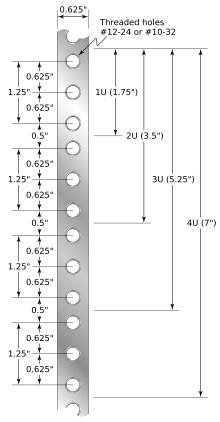Rack unit


A rack unit or U (less commonly, RU) is a unit of measure used to describe the height of equipment intended for mounting in a 19-inch rack or a 23-inch rack (the dimension referring to the width of rack). One rack unit is 1.75 in (44.45 mm) high.
One rack unit is commonly written as "1U"; similarly, 2 rack units are "2U" and so on. The size of a piece of rack mounted equipment is usually described as a number in "U".
Half-rack units typically describe units that fit in a certain number of rack units, but occupy only half the width of a 19-inch rack (9.5 in or 241 mm). These are commonly used when a piece of equipment does not require full rack width, but may require more than 1U of height. For example, a "4U half-rack" DVCAM deck would occupy 4U (7 in) height × 9.5 in width, and in theory, two 4U half-rack decks could be mounted side by side and occupy the 4U space.
A front panel or filler panel in a rack is not an exact multiple of 1.75-inches (44.45 mm). To allow space between adjacent rack mounted components, a panel is 1⁄32 inch (0.031 inch or 0.79 mm) less in height than the full number of rack units would imply. Thus, a 1U front panel would be 1.719 inches (43.66 mm) high. If n is number of rack units, the formula for panel height is h = (1.750n − 0.031) inch = (44.45n − 0.79) mm.
Coincidentally, a rack unit is equal to a vershok, an obsolete Russian length unit.
The rack unit size is based on a standard rack specification as defined in EIA-310.
External links
- EIA-310 standard at Electronic Industries Alliance website
